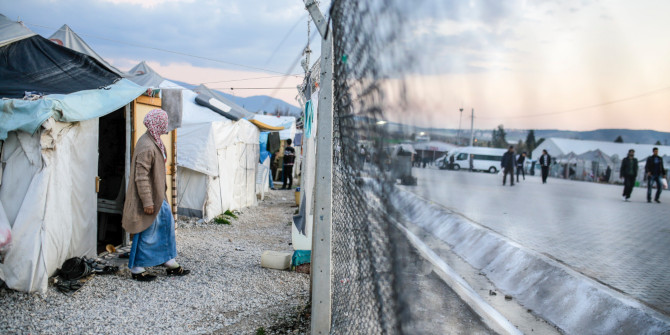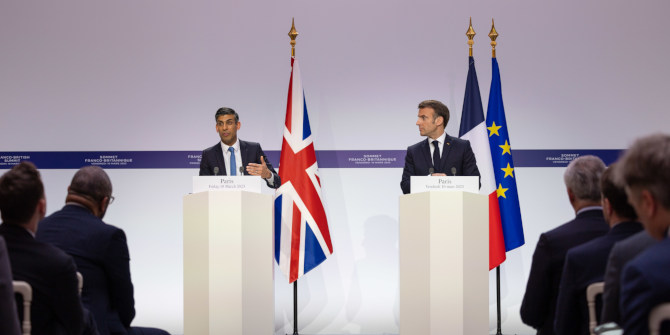 Several of the world’s largest arms manufacturers are located in Western Europe, but how has the arms industry developed in Central and Eastern Europe since the end of the Cold War? Yudit Kiss writes on the development of companies involved in weapons production in the region. She highlights three key global trends which characterise the industry: the impact of globalisation, the emergence of multiple new players, and the existence of blurred boundaries between civilian and military companies.
Several of the world’s largest arms manufacturers are located in Western Europe, but how has the arms industry developed in Central and Eastern Europe since the end of the Cold War? Yudit Kiss writes on the development of companies involved in weapons production in the region. She highlights three key global trends which characterise the industry: the impact of globalisation, the emergence of multiple new players, and the existence of blurred boundaries between civilian and military companies.
Stockholm-based SIPRI has recently published the latest database on global arms production. The material shows a fundamentally unchanged situation; for the last decades, by and large the same group of key companies headquartered in North America and Western Europe has dominated the world’s weapon production. The only remarkable exceptions, large-scale state-owned military-industrial complexes in China, some of which might well rank in the top 20, do not figure on the list, due to the lack of accessible output figures.
The global arms industry is a frozen, hierarchical system, characterised by tough competition, monopolistic positions and increasing costs. Underneath this seemingly static sphere, however, there is a rapidly changing, complex, busy underworld: the extremely competitive and mobile, multi-layered system of subcontractors. One of the fundamental changes of the last two decades has been the gradual transformation of the key weapon companies from primary producers into system integrators and the end products they offer contain key elements of their multiple sub-contractors.
Prime contractors have varied and complex relationships with their suppliers ranging from occasional sales or cooperation to joint ventures or straight ownership. Subcontractors might cater to various big players who compete with each other on the global arms market, but are also often tied together through joint projects and indirect links of shared inputs or cross-ownership.
The arms producers of East Central Europe (ECE) – Bulgaria, the Czech Republic, Hungary, Poland, Romania and Slovakia – represent a tiny segment of the world’s weapons production. Despite its modest size and subordinate status, the study of this segment provides important lessons about changing economic and social systems and industrial adjustment, highlighting major new trends in the world’s arms industry, some of which are described below.
Globalisation
During the Cold War period, the arms industry was an isolated universe in the Eastern bloc. Weapons production was a closed segment of national economies and arms were traded inside the Warsaw Pact system, with hardly any links to Western arms-manufacturers and only loose commercial ties with some left-leaning Third World countries. Today the region’s arms industry is integrated into national economies and has vital links with the world’s globalising weapon-producing networks and arms markets.

After having lost the large-scale and strictly regulated captive market that the Warsaw Pact represented, the region’s arm producers have made considerable efforts to reach new outlets all over the world. Since NATO-related markets are difficult to enter, most ECE produced military items are sold in Asia, Africa, the Middle East and some Latin American countries.
A restricted group of the top producers succeeded in weathering the radical transformations that have decimated the sector since the end of the Cold War, and were able to reach a stable second or third-tier subcontractor status in the ever more globalising supply-chains of the large players. The experience of ECE companies confirms research findings about the nature of these networks; the global arms industry is a complex, hierarchical, uneven playing field, where smaller and economically/politically weaker actors have serious disadvantages that are nearly impossible to surmount.
In the past, state orders and state-financing were indispensable for the survival of arms firms in ECE. State backing is still crucially important, even though its forms and intensity have significantly changed, but foreign markets and international partnerships have also become essential factors underpinning success. However, they are difficult to secure, even for the most outstanding companies. After some successful export deals related to Poland’s participation in the US-led Afghan and Iraq military interventions, Bumar, the country’s principal arms seller, lost several international bids due to its disadvantaged position in the market.
In the 1990s the big success story of the region’s arms industrial adjustment was a joint venture set up by the American company Boeing and the Czech company Aero Vodochody to produce and market together the Czech firm’s L-159 aircraft. The partnership turned into a costly failure and the Czech state had to take the plant back – they eventually sold it some years later to Penta Investments, a Slovak-Czech private equity fund.
The takeovers of the two leading Polish aircraft companies, PZL Mielec by US-based Sikorsky (part of the UTC holding), and PZL Swidnik by Italian Finmeccanica – AgustaWestland, that took place in the early 2000s, were more successful, indicating an increasing maturity of the business partners on both sides. These achievements, at the same time, might prompt decision-makers to reformulate their goals. After two decades of a bumpy adjustment process, thanks to the joint efforts of the enterprise, regional and national authorities, PZL Mielec surfaced as a major national company in the centre of an emerging region. After its sale, the firm went through a profile modification and became part of Sikorsky Aircraft’s global production network that includes production sites in the United States, Poland, Turkey, China, India and the Czech Republic.
Globalisation, outsourcing and the diversification of markets are certainly convenient for individual companies, but due to the proliferation of arms and arms-producing facilities they also represent considerable security risks.
New players
The geographical diversification of arms industry actors and the increasing importance of emerging economies are fairly noticeable in ECE as well. New business relationships are set up with Asian, African and Latin American partners. One of the most outstanding ECE companies, the Sellier & Bellot ammunition producer (a traditional stronghold of the Czech arms industry) for instance, was bought by the Brazilian Companhia Brasileira de Cartuchos, which has daughter companies in the U.S. and Germany as well.
In recent decades there has been a multiplication of defence industry players in Eastern Europe, largely due to the decentralisation and privatisation of the large-scale state owned enterprises which previously existed in the region, and economic liberalisation policies which have made entry into the sector more accessible.
In each country a small group of private start-up companies has emerged, with well-trained workforces, cutting edge technology and efficient, flexible management, usually at the high-end of the sector. Most are small or medium-sized enterprises, set up by a group of friends, former schoolmates or colleagues. They often started with a very modest capital investment, typically family savings, although some could count on foreign capital investment, usually thanks to personal connections. At the beginning these firms appeared at the margins of the arms industry providing niche products, but in a short period of time they managed to carve out a place for themselves both in domestic and export markets.
The Polish WB Electronics company, a champion of battlefield automation, for example, was established in the late 1990s by three friends. Poland’s defence sector is predominantly state owned and initially the authorities had difficulties in accepting the rise of such companies. However, WBE’s outstanding products soon made it indispensable, with the firm’s devices becoming integrated into the national armed forces’ equipment, and receiving offers for exports. By 2014, the WBE Group employed 850 people and consisted of five firms, including ZR Radmor, a long-standing electronics and radio equipment firm which was a privatised former state owned enterprise, and Flytronic, which specialises in surveillance and reconnaissance systems based on unmanned aerial vehicles.
Few of these new start-up companies are entirely military-related. Most are ‘amphibians’ which are able to switch rapidly between military and civilian activity depending on the changing demands of their environment. In the past, most weapon makers were dual-use producers, but their defence-related activity was dominant and civilian production principally served to compensate for the fluctuations of the military demand. Thanks to their flexibility and high level of assets, today’s ‘amphibians’ have a genuinely dual nature and are able to enter and exit the sector.
After providing a high quality ‘C4I System’ (Command, Control, Communications, Computers, and Intelligence) to the Bulgarian Ministry of Defence, Sirma Solutions, one of the most prosperous Bulgarian IT companies, seems to have left the defence-related field completely. The Polish Andoria Co., a civilian vehicle-maker, acquired a NATO supplier certificate that helped it to benefit from an offset deal and become a subcontractor of a U.S. company that was supplying military equipment to Iraq. After fulfilling the contract, Andoria returned to fully civilian activity. The Hungarian Pro-Patria Electronics sold its high-tech surveillance and early warning systems on civilian markets, but after a major Ministry of Defence order, it underwent a profile change and became a leading defence firm. When state orders dried up, the company switched to civilian export markets, but keeps its military-related profile on hold.
Financial investors are also newcomers in the ECE defence field. Benefiting from the waves of privatisation and new business opportunities opening after the collapse of the previous system, a new domestic entrepreneurial class has emerged in each country with a handful of diversified business empires. Some of these groups, like the Czech-Slovak Penta Investments, Slovakia’s Sitno Investment Holding, or the Bulgarian Georgi Krumov’s portfolio, integrated weapons companies that managed to survive the roller-coaster years of the post-Cold War period and become successful.
The entry of financial capital provides badly needed fresh resources for the sector, though in several cases the investors rapidly got rid of arms firms because they didn’t produce the expected increase in profits quickly enough. Financial investors aiming at high and quick returns have put pressure on arms makers, which might represent a serious risk as short-term profitability considerations have the potential to outweigh security considerations.
Blurred identities
Under the previous system, the military-related segment of the economy had clear-cut borders: weapons were manufactured by a relatively closed group of state-owned companies inside national boundaries. Today’s liberalisation, increasing division of labour, globalisation and the dominance of integrated systems that replace “homogenous” end-products, blur the boundaries between national/international and civilian/military industry.
The ownership structures, product ingredients and production processes have become so diversified and dispersed that it is becoming difficult to define the national identity of a product or a company. Facing budget constraints, weapon producers strive to widen the scope of their activity, including reaching out to fields like homeland security or environmental protection. Aware of the greater creativity, flexibility and adaptability of civilian companies, military-related firms try to integrate them or their products into their networks. At the same time, highly lucrative military-related activities represent a strong attraction for high-tech civilian companies that might easily turn into ‘amphibians’.
Arms making in ECE – and all over the world – is more and more characterised by hybrid systems, both at the level of production process and the composition of output. Partially as a reaction to shrinking defence budgets, revamping and modernising legacy systems with latest technology devices has become one of the most successful activities in ECE. Israeli firms present in the region have been notably successful in promoting hybrid solutions, updating existing military hardware with the latest, freshest devices, and this path is followed by many local and foreign companies. Very often, these systems are produced by different types of producers, including state-owned companies, small and large-scale enterprises, domestic and foreign-based ones.
For more on this topic see the author’s recent book, Arms Industry Transformation and Integration: The Choices of East Central Europe (Oxford University Press, 2014)
Please read our comments policy before commenting.
Note: This article gives the views of the author, and not the position of EUROPP – European Politics and Policy, nor of the London School of Economics.
Shortened URL for this post: http://bit.ly/17Z9owo
_________________________________
 Yudit Kiss
Yudit Kiss
Yudit Kiss is an independent economic researcher from Hungary, based in Geneva. Her academic publications deal with the post-Cold War economic transformations of Central Europe. Her latest book is Arms Industry Transformation and Integration: The Choices of East Central Europe (OUP 2014).





